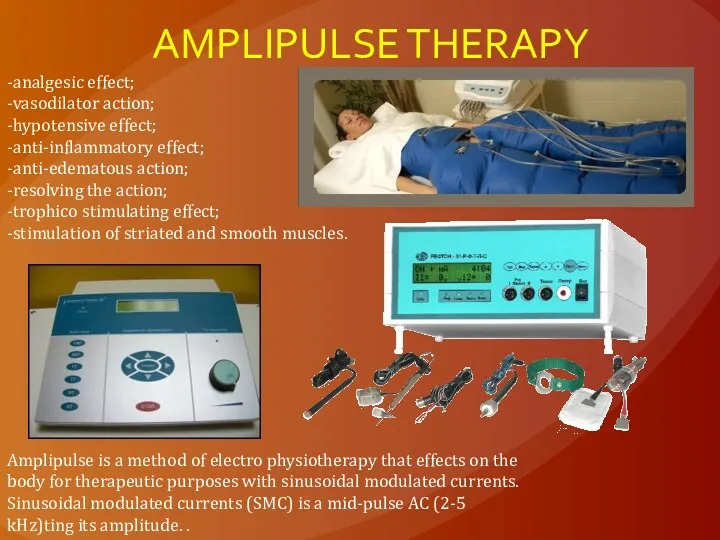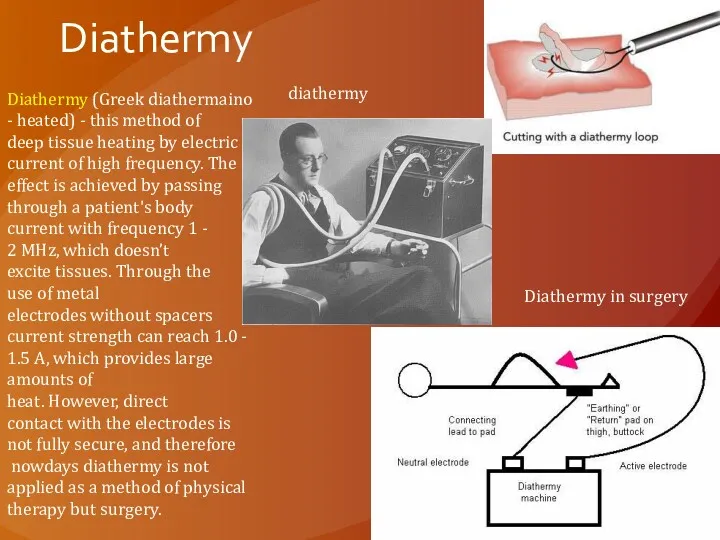Содержание
- 2. MEDICAL ELECTRODES & THEIR FORMS An electrode is an electrical conductor used to make contact with
- 3. MEDICAL ELECTRODES & THEIR FORMS ECG electrodes Heart stimulator electrodes colposcopy-loop-electrodes
- 4. MEDICAL ELECTRODES & THEIR FORMS
- 5. TRANSDUCERS A transducer is a device that converts one type of energy to another. Energy types
- 6. ELECTRONIC AMPLIFIERS
- 7. AMPLIFIER SCHEME
- 8. AMPLIFIER CHARACTERISTIC Frequency characteristic 1 - bandwidth, within which the amplification is the same for signals
- 9. The frequency characteristic of the dc amplifier The frequency characteristic of the dc amplifier differs from
- 10. Amplitude characteristic of the amplifier shows the dependence of the amplification coefficients on the amplitude of
- 11. 1. Protection circuit protects the input circuits of the instrument from the random effects of high
- 12. ELECTRONIC STIMULATORS. PHYSIOTHERAPEUTICS. Rieznyk A.
- 13. IMPULSE SHAPE Electrical impulse – is a short burst of electrical voltage or current in a
- 14. IMPULSE To excite nervous or muscular cells , an electrical impulse must have an amplitude exceeding
- 15. ELECTRONIC OSCILLATOR An electronic oscillator is an electronic circuit that produces a repetitive electronic signal, often
- 16. STIMULATORS Cardio stimulators Myostimulators Nerve stimulator
- 17. ELECTRO PHYSIOTHERAPY The use of electrotherapy has been researched and accepted in the field of rehabilitation[
- 18. ELECTRO PHYSIOTHERAPY Electro physiotherapy – is a method of therapy using direct or alternating current. There
- 19. AMPLIPULSE THERAPY -analgesic effect; -vasodilator action; -hypotensive effect; -anti-inflammatory effect; -anti-edematous action; -resolving the action; -trophico
- 20. Diadynamic Diadynamic - this method effects on organism with the low-frequency current. Current frequency at 50
- 21. Darsonvalization Darsonvalization (named by one of the founders of Physiotherapy - D'Arsonval) - method of electro
- 22. Diathermy Diathermy (Greek diathermaino - heated) - this method of deep tissue heating by electric current
- 23. Inductotermy Inductotermy -method of Electro physiotherapy, which includes impact on patient's body with electromagnetic field of
- 25. Скачать презентацию






















 Методы в гистологии
Методы в гистологии Автокөлік жарақаты оның және түрлері. Автокөлік жарақатындағы жарақаттардың ерекшеліктері және оның бұзылу механизімдері
Автокөлік жарақаты оның және түрлері. Автокөлік жарақатындағы жарақаттардың ерекшеліктері және оның бұзылу механизімдері Особо опасные, карантинные инфекции. Тактика врача СНМП при выявлении особо опсной инфекции. Диагностика. Неотложная помощь
Особо опасные, карантинные инфекции. Тактика врача СНМП при выявлении особо опсной инфекции. Диагностика. Неотложная помощь Нервно-психическое развитие здорового ребенка
Нервно-психическое развитие здорового ребенка Клещевой энцефалит
Клещевой энцефалит Современные инсектоакарицидные препараты
Современные инсектоакарицидные препараты Рак яичников
Рак яичников Травы для детей и мам. Биологически активные вещества растений
Травы для детей и мам. Биологически активные вещества растений Дитина з малою масою тіла
Дитина з малою масою тіла Гипертоническая болезнь и симптоматические артериальные гипертензии
Гипертоническая болезнь и симптоматические артериальные гипертензии Возможности высокопольной МРТ в диагностике наследственных и редких врожденных заболеваний. Лекция 2
Возможности высокопольной МРТ в диагностике наследственных и редких врожденных заболеваний. Лекция 2 Основные подходы к оценке состояния речи ребенка на ПМПК
Основные подходы к оценке состояния речи ребенка на ПМПК Променева діагностика захворювань серця і судин
Променева діагностика захворювань серця і судин Комплекс упражнений для глаз
Комплекс упражнений для глаз Типовые нарушения водного баланса
Типовые нарушения водного баланса Лекарственные средства, влияющие на ЦНС
Лекарственные средства, влияющие на ЦНС Возрастные изменения основных систем
Возрастные изменения основных систем Апаттар медицинасын ұйымдастыру принциптері
Апаттар медицинасын ұйымдастыру принциптері Бүйрек-зәрдік синдром мен зәрдің тұну элементтерінің клинико-диагностикалық маңызы
Бүйрек-зәрдік синдром мен зәрдің тұну элементтерінің клинико-диагностикалық маңызы Стандартизация и анализ глазных лекарственных средств. Ушные и назальные ЛС
Стандартизация и анализ глазных лекарственных средств. Ушные и назальные ЛС Грязелечение
Грязелечение Методы лабораторной и визуальной диагностики бронхолегочной патологии
Методы лабораторной и визуальной диагностики бронхолегочной патологии Первые признаки инсульта. Меры неотложной помощи
Первые признаки инсульта. Меры неотложной помощи Сахарный диабет 1 типа у детей раннего возраста: помповая инсулинотерапия, клинические примеры
Сахарный диабет 1 типа у детей раннего возраста: помповая инсулинотерапия, клинические примеры Двигательно-рефлекторная сфера. Анатомо-физиологические особенности. Центральный и периферический параличи
Двигательно-рефлекторная сфера. Анатомо-физиологические особенности. Центральный и периферический параличи Бауыр ауруларының патоморфологиялық сипаттамасы. Балалардағы ерекшеліктері. Аралық бақылау
Бауыр ауруларының патоморфологиялық сипаттамасы. Балалардағы ерекшеліктері. Аралық бақылау Инновационные методы диагностики ревматических заболеваний
Инновационные методы диагностики ревматических заболеваний Сестринский уход при бронхиальной астме
Сестринский уход при бронхиальной астме